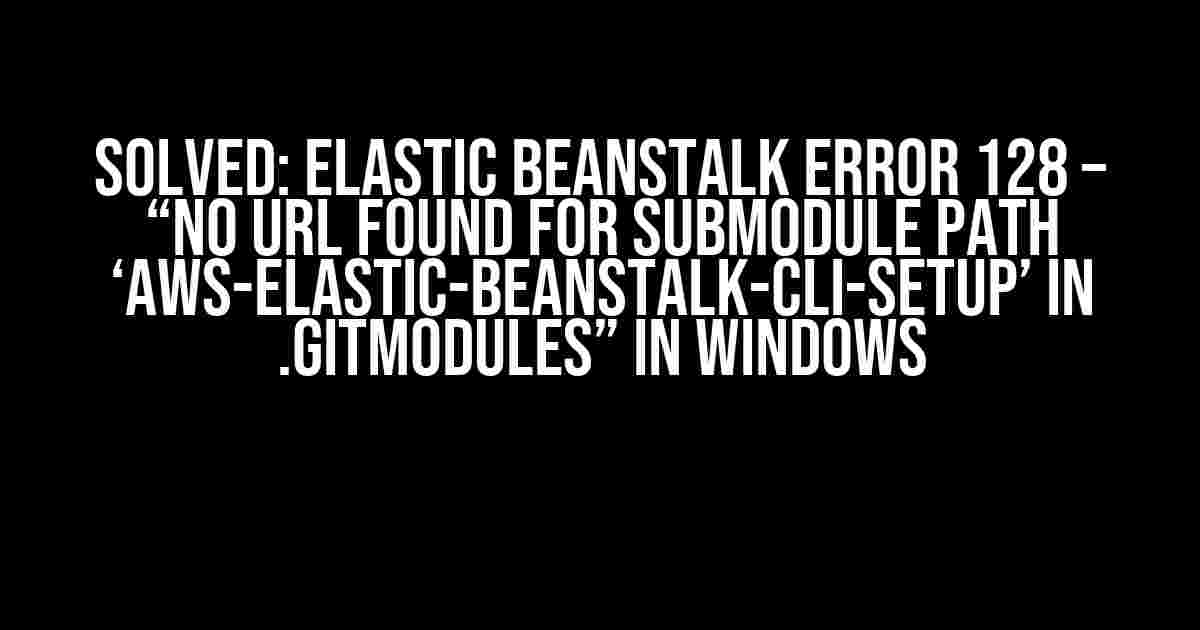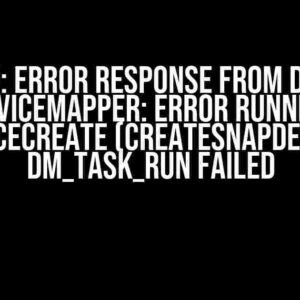If you’re reading this, chances are you’re frustrated with the infamous Elastic Beanstalk error 128 that’s blocking your progress. Don’t worry, you’re not alone! In this in-depth guide, we’ll walk you through the solutions to get you back on track. By the end of this article, you’ll be able to tackle that pesky error and deploy your application with ease.
What is Elastic Beanstalk Error 128?
Elastic Beanstalk error 128 is a common issue that occurs when trying to deploy an application to AWS Elastic Beanstalk using the Elastic Beanstalk CLI. The error message usually reads:
Error 128: No URL found for submodule path 'aws-elastic-beanstalk-cli-setup' in .gitmodules
This error is often caused by a misconfigured `.gitmodules` file or issues with the Git Submodule setup. But don’t worry, we’ll dive into the details and provide step-by-step solutions to overcome this hurdle.
Understanding Git Submodules
Before we dive into the solutions, let’s take a brief moment to understand Git Submodules. Git Submodules allow you to include other Git repositories within your main project’s repository. This is useful when you need to include external libraries or dependencies in your project.
In the context of Elastic Beanstalk, the `aws-elastic-beanstalk-cli-setup` submodule is used to configure the CLI setup for your application. However, when the `.gitmodules` file is not configured correctly, it can lead to error 128.
Solution 1: Verify and Update .gitmodules File
The first step is to verify the contents of your `.gitmodules` file. Open the file in a text editor and check if the `[submodule “aws-elastic-beanstalk-cli-setup”]` section is present and correctly configured.
[submodule "aws-elastic-beanstalk-cli-setup"]
path = aws-elastic-beanstalk-cli-setup
url = https://github.com/aws/aws-elastic-beanstalk-cli-setup.git
If the section is missing or the URL is incorrect, update the file accordingly. Save the changes and try running the Elastic Beanstalk CLI command again.
Solution 2: Initialize and Update Git Submodules
Another common issue is that the Git Submodules are not initialized or updated correctly. To resolve this, run the following commands in your terminal:
git submodule init git submodule update
This will initialize and update the Git Submodules, including the `aws-elastic-beanstalk-cli-setup` submodule. After running these commands, try deploying your application to Elastic Beanstalk again.
Solution 3: Delete and Re-clone the Submodule
If the above solutions don’t work, try deleting the `aws-elastic-beanstalk-cli-setup` submodule and re-cloning it. Run the following commands:
git submodule deinit aws-elastic-beanstalk-cli-setup git rm aws-elastic-beanstalk-cli-setup git submodule add https://github.com/aws/aws-elastic-beanstalk-cli-setup.git aws-elastic-beanstalk-cli-setup git submodule update
This will remove the submodule and re-clone it from the correct repository. After re-cloning, try deploying your application to Elastic Beanstalk again.
Solution 4: Check for Git Version Compatibility
If you’re using an older version of Git, it might be incompatible with the `aws-elastic-beanstalk-cli-setup` submodule. Ensure you’re running the latest version of Git. You can check your Git version by running:
git --version
If you’re running an older version, update Git to the latest version and try deploying your application to Elastic Beanstalk again.
Solution 5: Check for Windows-specific Issues
If you’re experiencing this error on a Windows machine, there might be Windows-specific issues at play. One common issue is the Windows-style path separator (`\`) in the `.gitmodules` file. Try updating the file to use the Unix-style path separator (`/`) instead:
[submodule "aws-elastic-beanstalk-cli-setup"]
path = aws-elastic-beanstalk-cli-setup
url = https://github.com/aws/aws-elastic-beanstalk-cli-setup.git
Becomes:
[submodule "aws-elastic-beanstalk-cli-setup"]
path = aws-elastic-beanstalk-cli-setup/
url = https://github.com/aws/aws-elastic-beanstalk-cli-setup.git
Save the changes and try deploying your application to Elastic Beanstalk again.
Troubleshooting Tips
If none of the above solutions work, here are some additional troubleshooting tips to help you overcome the Elastic Beanstalk error 128:
- Check for any typos or incorrect URLs in the `.gitmodules` file.
- Verify that the `aws-elastic-beanstalk-cli-setup` submodule is correctly initialized and updated.
- Try deleting the entire `.git` directory and re-initializing the Git repository.
- Check the Elastic Beanstalk CLI version and ensure it’s up-to-date.
- Reach out to AWS support or online communities for further assistance.
Conclusion
In this comprehensive guide, we’ve covered the most common solutions to overcome Elastic Beanstalk error 128. By following the step-by-step instructions and troubleshooting tips, you should be able to resolve the issue and successfully deploy your application to Elastic Beanstalk.
Remember, error 128 is often a sign of a misconfigured `.gitmodules` file or issues with the Git Submodule setup. By understanding the root cause of the error and applying the correct solutions, you’ll be able to overcome this hurdle and focus on building amazing applications on AWS Elastic Beanstalk.
| Solution | Description |
|---|---|
| Verify and Update .gitmodules File | Check and update the .gitmodules file to ensure the submodule is correctly configured. |
| Initialize and Update Git Submodules | Run git submodule init and git submodule update to initialize and update the Git Submodules. |
| Delete and Re-clone the Submodule | Delete the submodule and re-clone it from the correct repository. |
| Check for Git Version Compatibility | Ensure you’re running the latest version of Git to avoid compatibility issues. |
| Check for Windows-specific Issues | Update the .gitmodules file to use the Unix-style path separator (/) instead of the Windows-style path separator (\). |
By following these solutions and troubleshooting tips, you’ll be able to overcome Elastic Beanstalk error 128 and get back to building amazing applications on AWS Elastic Beanstalk.
Frequently Asked Question
Are you stuck with the frustrating Elastic Beanstalk error 128 in Windows? Don’t worry, we’ve got you covered! Here are some frequently asked questions and answers to help you troubleshoot and resolve the issue.
What is Elastic Beanstalk error 128, and why do I see it?
Elastic Beanstalk error 128 occurs when there’s an issue with the Git submodule configuration in your project. In this specific case, the error message “No url found for submodule path ‘aws-elastic-beanstalk-cli-setup’ in .gitmodules” indicates that the system can’t find the URL for the submodule ‘aws-elastic-beanstalk-cli-setup’ in the .gitmodules file.
How do I fix the error 128 in my Windows environment?
To resolve the issue, you need to update the .gitmodules file to include the correct URL for the submodule ‘aws-elastic-beanstalk-cli-setup’. You can do this by running the command `git submodule add https://github.com/aws/aws-elastic-beanstalk-cli-setup.git .gitmodules` in your project directory.
What if I’m still getting the error 128 after updating the .gitmodules file?
If you’re still encountering the error, try deleting the .gitmodules file and running the command `git submodule init` to re-initialize the submodule. Then, update the .gitmodules file again with the correct URL. This should fix the issue.
Is there a way to avoid this error in the future?
Yes, to prevent this error from occurring in the future, make sure to regularly update your Git submodules by running the command `git submodule update –init –recursive` in your project directory. This will ensure that your submodules are up-to-date and configured correctly.
What if I’m not comfortable with command-line Git commands?
No worries! If you’re not comfortable with command-line Git commands, you can use a Git GUI client like Git Kraken, Git Tower, or Git Extensions to manage your submodules and update the .gitmodules file.




